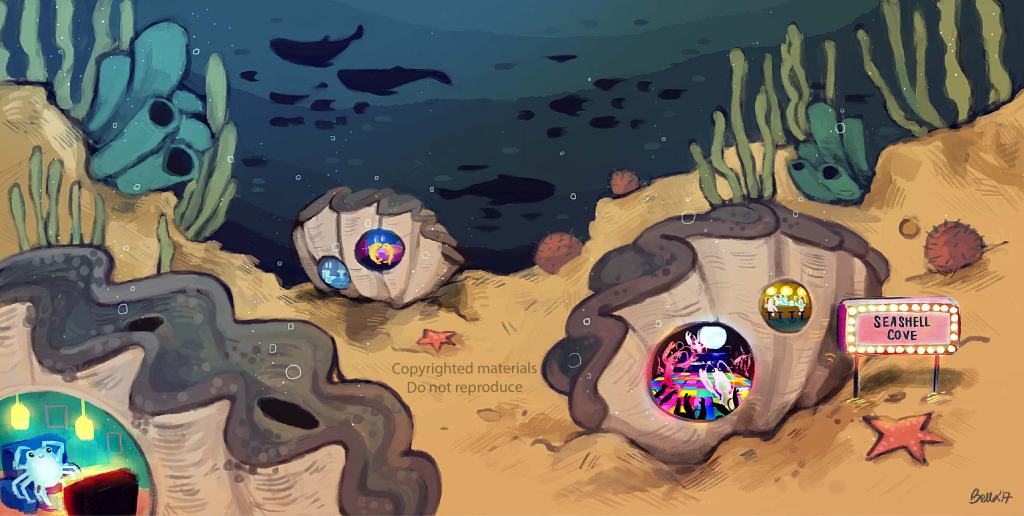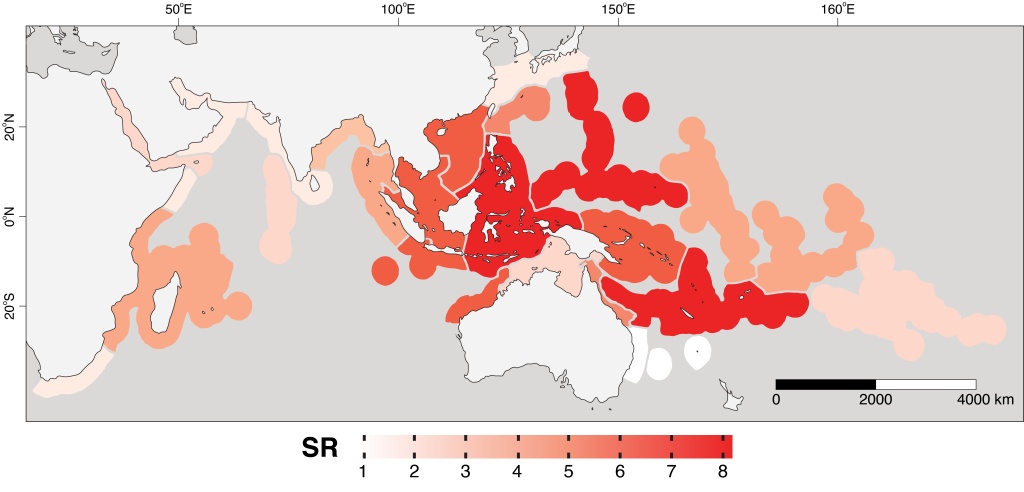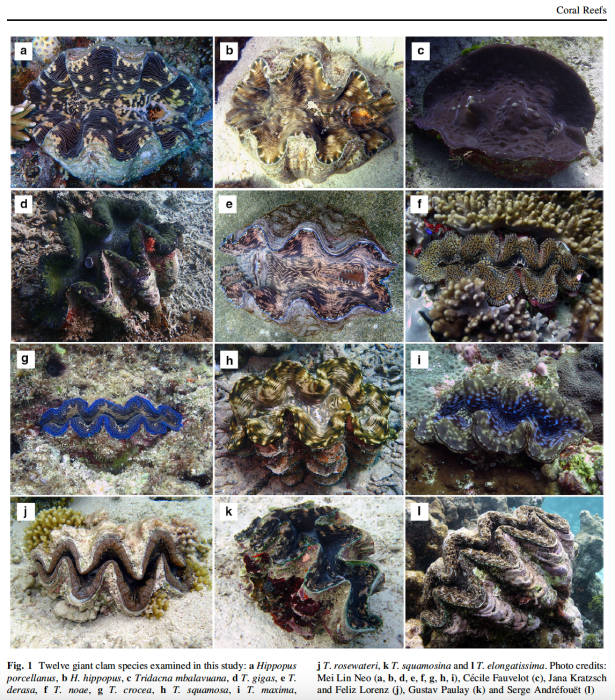
Giant clams (subfamily Tridacninae) are the world’s largest living marine bivalves. The largest of all species, Tridacna gigas can grow up to 1 m long, and weigh over 250 kg! Highly conspicuous with their vibrant mantle colours and patterns, these animals are mostly found within the shallow tropical coral reefs of the Indo-Pacific (Fig. 1).
Figure 1. Species richness of giant clams across the 25 provinces within the Indo-Pacific realm. Source: Tan et al., 2022. Diversity and Distributions.
Figure 2. Twelve species of giant clam species. Source: Tan et al. 2022. Coral Reefs.
Currently, there are 12 described species classified into two genera: Hippopus and Tridacna (see Fig. 2). Tridacna ningaloo was synonymised with T. noae (Borsa et al. 2015), and Tridacna lorenzi was recently synonymised with T. rosewateri (Fauvelot et al. 2020). In 2020, a newly resurrected species – Tridacna elongatissima was described from the Western Indian Ocean (Fauvelot et al. 2020). According to Neo et al. (2017), many of the tridacnine species are facing threats from over-exploitation (for food and shells) and loss of habitats. A recent example of intense exploitation is the harvesting of fossilised shells from the South China Sea.
Ten interesting facts about the Giant Clam:

Legends tell of a man whose legs were lost to a giant clam! Illustration by Kenneth Chin.
- Historically, giant clams were notoriously believed to be man-eaters due to their large gape size and ability to clam up! However, there have been no records of human mortality.
- Giant clams are very long-lived animals in the wild! Some say they can live up to 100 years or more!
- Giant clams are simultaneous hermaphrodites – possessing both male and female sexual organs (when mature).
- Giant clams are highly fecund. A single mature Tridacna gigas can produce up to 500 million eggs in one spawning!
- Giant clams share a unique symbiotic relationship with a type of microalgae: zooxanthellae (Symbiodinium spp.). The clams host the zooxanthellae shelter and protection from UV, while zooxanthellae provides food to the clam hosts.
- Although giant clams remain largely sessile throughout their life history, the large animals have displayed an array of behaviour patterns!
- Giant clams can ‘see’ using their light sensitive photo-receptors to detect changes in light intensity.
- Giant clams can squirt an accurate jet of water at a target!
- Giant clams are highly valued by Asian gastronomes, particularly for their adductor muscles.
- Giant clams play numerous ecological roles in the coral reef ecosystems, such as providers of food and shelters, contributors to reef productivity, and builders and shapers of reefs.

Giant clams are important ecosystem engineers! Illustration by Isabella Tong.
Selected further readings:
- Fauvelot, C et al. (2020) Phylogeographical patterns and a cryptic species provide new insights into Western Indian Ocean giant clams phylogenetic relationships and colonization history. Journal of Biogeography 47: 1086-1105.
- Heslinga, GA and WK Fitt (1987) The domestication of reef-dwelling clams. BioScience 37(5): 332-339.
- Huang, D et al. (2007) Movement and aggregation in the fluted giant clam (Tridacna squamosa L.). Journal of Experimental Marine Biology and Ecology 342: 269-281.
- Lucas, JS (1994) The biology, exploitation, and mariculture of giant clams (Tridacnidae). Reviews in Fisheries Science 2(3): 181-223.
- Mingoa-Licuanan, SS and ED Gomez (2002) Giant clam conservation in Southeast Asia. Tropical Coasts: 24-31.
- Neo, ML and PA Todd (2011) Quantification of water squirting by juvenile fluted giant clams (Tridacna squamosa L.). Journal of Ethology 29: 85-91.
- Neo, ML et al. (2015) The ecological significance of giant clams in coral reef ecosystems. Biological Conservation 181: 111-123.
- Neo, ML et al. (2017) Giant clams (Bivalvia: Cardiidae: Tridacninae): A comprehensive update of species and their distribution, current threats and conservation status. Oceanography and Marine Biology: An Annual Review 55: 87-388.
- Shang, YC et al. (1991) Report on a market survey of giant clam products in selected countries. Center for Tropical and Subtropical Aquaculture Publication Number 107. 24pp.
- Soo, P and PA Todd (2014) The behaviour of giant clams (Bivalvia: Cardiidae: Tridacninae). Marine Biology 161(12): 2699-2717.
- Tan, EYW et al. (2022) Genome skimming resolves the giant clam (Bivalvia: Cardiidae: Tridacninae) tree of life. Coral Reefs 41(3): 497-510.
- Tan, EYW et al. (2022) Assessing taxonomic, functional and phylogenetic diversity of giant clams across the Indo-Pacific for conservation prioritization. Diversity and Distributions.
- Trench, RK et al. (1981) Observations on the symbiosis with zooxanthellae among the Tridacnidae (Mollusca: Bivalvia). Biological Bulletin 161(1): 180-198.
- Wilkens, LA (1986) The visual system of the giant clam Tridacna: Behavioural adaptations. Biological Bulletin 170: 393-408.
- Yamaguchi, M (1977) Conservation and cultivation of giant clams in the tropical Pacific. Biological Conservation 11: 13-20.



about the identification is there any references or officall dichotmus key for giant clam
There are several dichotomous key for the giant clam species, but none are comprehensive enough. Most of them are found in books too, so I don’t have any soft copies to share.
Good afternoon Dr. Mei lin! i am a B.S biology student in the philippines doing my thesis on giant clams as well! i have so much inquiries about these beautiful species but i am really curious about what sizes are the clams sexually mature? especially the T. noae since it was just recently discovered. thank you very much!!
Hello Karen! Sorry to miss your message, and hope my reply is still useful for you.
Regarding the sizes of giant clams at sexual maturity, there are no standard sizes, and it depends on species. Taking Tridacna noae as example, the individuals are female mature around 16cm and above.
You could read some of the recent publications by Dr Paul Southgate and Dr Rick Braley on aquaculture of Tridacna noae. 🙂
I really love all the information you will be a hero to me.
Hi Mei Lin!
I am an art student studying fiber and textile design in the United States of America. I am currently working on a project about Giant Clams inspired by your TED talk. I am wondering if there are any groups that accept donations to help with conservation efforts for Giant Clams? How can someone like me help these amazing creatures? I want to spread the word about them!
Hello Arynn, Nice to meet you! Thank you for watching my TED talk! Glad to hear it inspired you and for your art work! There is no current groups accepting donations specially for conservation efforts for Giant Clams. Most efforts are localized and you can help if you visit these conservation works. As a start, share what you’ve learnt, and two, don’t support the shell ornaments! Thank you very much! 🙂
Hi Mei Lin,
I’m from Singapore too, I started out as a marine hobbyist for over 10 years and recently started my own coral shop. Would you be able to give me some advise to further improve my tanks?
Many thanks
Hello Chee Feng,
Thanks for your note! Could you give me more information about what sort of tanks are you referring to? I am more familiar with a flow-through seawater system, but less knowledge of hobbyist aquarium systems. You can get in touch with me via my work email to discuss further on your question: tmsnml@nus.edu.sg
Hi Neo Mei Lin,
As a researcher and former hatchery breeder of giant clam in Thailand since 1990s and also have had experience working on breeding of Tridacna costata or presently T. squamosina in Aqaba once in 2010, I found your blog very interesting to read. Love it!
Thanks for sharing.
All the best,
Jintana Nugranad
Hello Jintana! Thank you for your lovely message! Pls spread the word to conserve giant clams! 🙂
Best wishes,
Mei Lin
Hi Mei Lin,
My email address is cooinda14@gmail.com
Many thanks,
Carolyn
Thank you Mei Lin, if you could continue with enquiries about the giant, fluted clam exhibit donated by my grandfather that would be appreciated. I read some years ago that a giant clam exhibit was transferred from Singapore to Ireland (a marine museum?) and wonder if there is any Singapore museum record or details of that?
Hello Carolyn. Good to hear back from you! Do you have an email that I can communicate with you? It will be easier to share what I have found out so far regarding your request. Thank you!
Hello MeI Lin,
I am wondering if during your research on giant fluted clams whether you came across a museum exhibit of such a clam in Singapore? My grandfather, Captain James Adam Milne, who resided in Singapore from 1900 – 1945, donated a giant fluted clam to the Singapore Museum. I used to visit the Museum on my school excursions and know that the exhibit was there in the 1970s. The giant clam sat in a single show case on the st floor of the old Singapore Museum on Stamford Road near the Cathay Building. When the Museum was closed the clam was moved with its cabinet to the Coralarium on Sentosa Island. I believe the Coralarium on Sentosa closed in 1994 and my family and I have been trying to trace that clam ever since so our family’s younger generation can visit to view it. The cabinet housing the giant clam had the caption “Donated by Captain James Adam Milne”.
Hoping by chance you might know the whereabouts.
Many thanks for any help you can give us,
Carolyn Milne Bennett
Hi Carolyn,
Thanks for sharing this information! During my research, I did not come across your grandfather’s exhibit, as it may have been relocated. Let me speak with a few colleagues to see if we can help to trace back the shell! 🙂
Best regards,
Mei Lin
Hi Neo Mei Lin,
I have been working on giant clams since 1979 and my PhD thesis was on the two largest species. See my website at http://www.aquasearch.net.au and also see http://www.djulinmarine.com We are waiting to find an investor in a hatchery and farm. It should have happened 30 yr. ago when we had such a successful project in No. Queensland, then we would have 80 -90 cm aquacultured shells to cover the Chinese demand for this item. My email is giantclamman@gmail.com
Cheers, Dr. Rick Braley